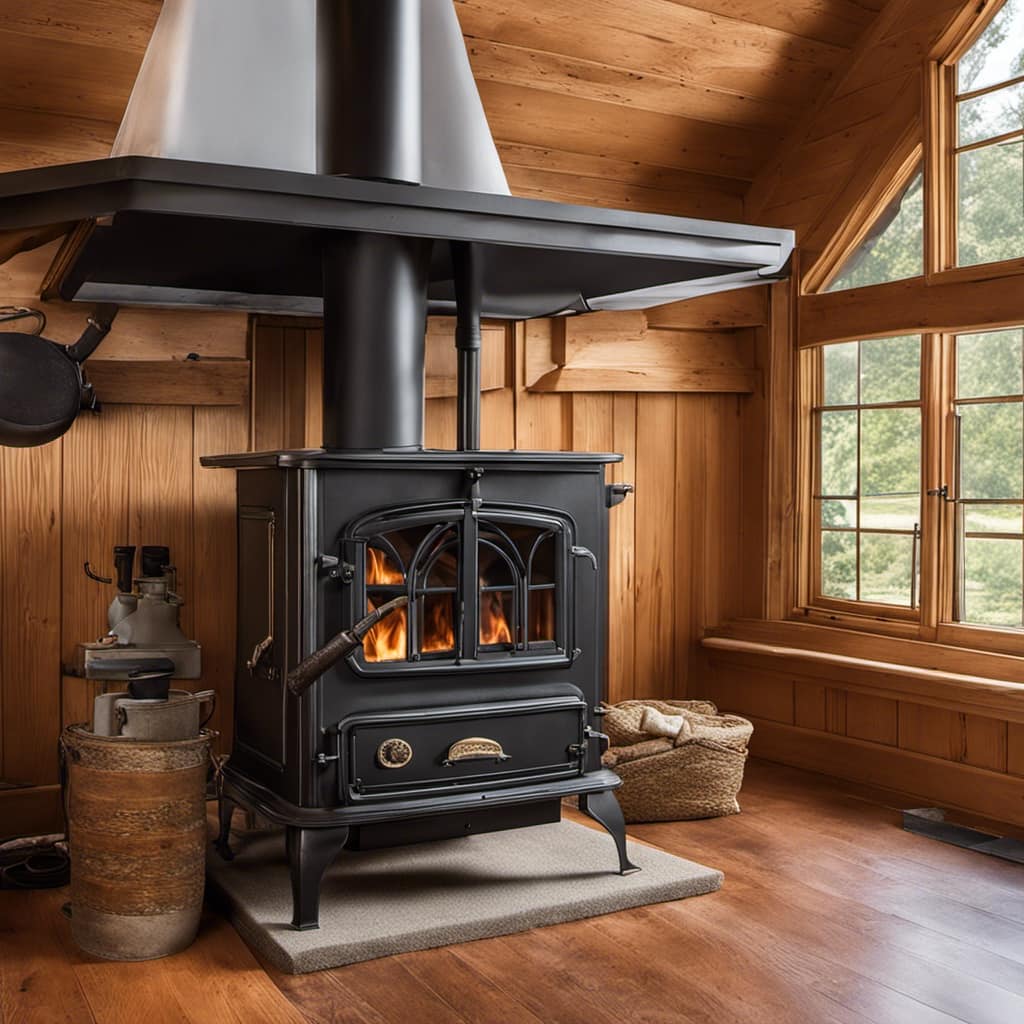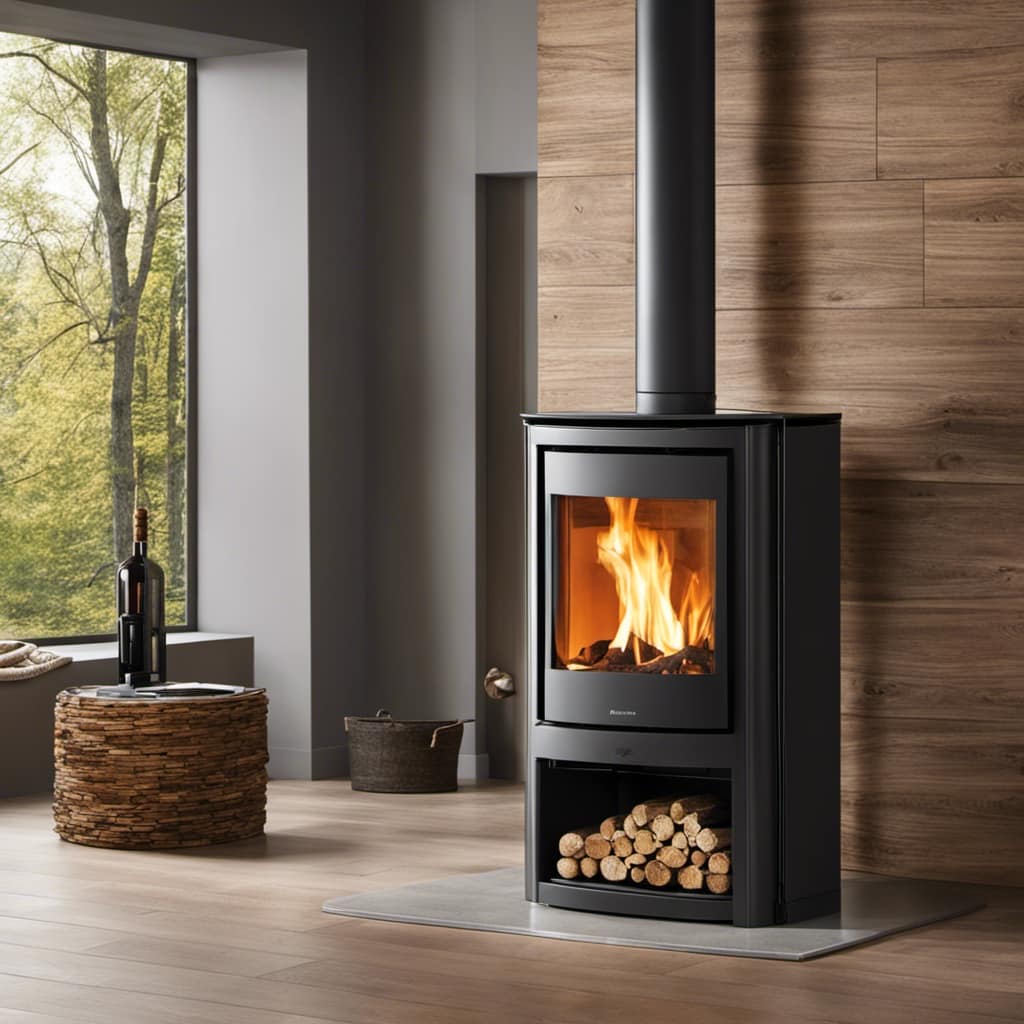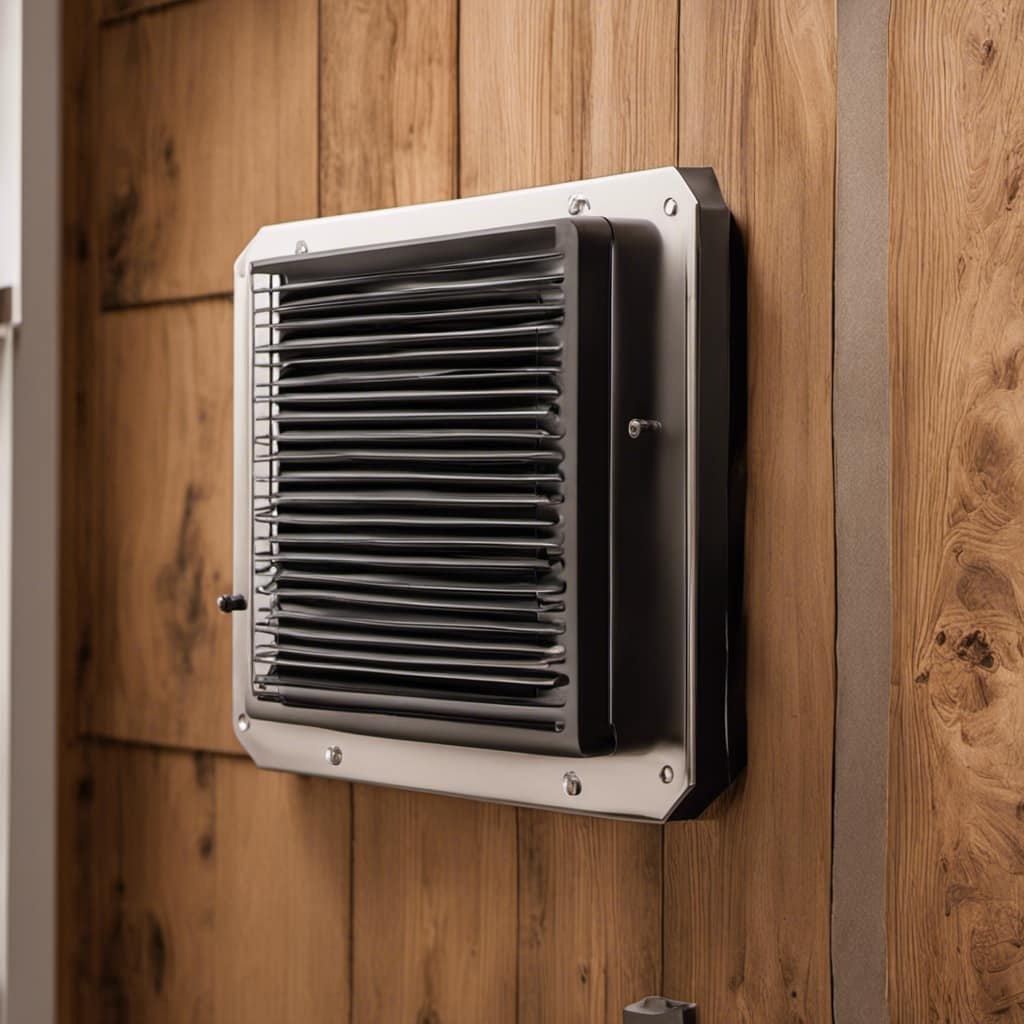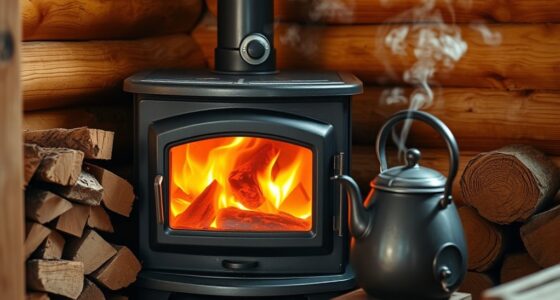Allow me to present to you the wonders of non-catalytic wood stoves. These amazing appliances are revolutionizing home heating, improving both efficiency and sustainability.
Using advanced combustion technology, they maximize heat output and minimize harmful emissions.
In this article, I’ll delve into how non-catalytic wood stoves work, their advantages over catalytic ones, and the key features to consider when choosing one.
Get ready to discover the perfect heating solution for your home!

Key Takeaways
- Non catalytic wood stoves rely on secondary combustion for high efficiency and low emissions.
- They burn wood more efficiently, resulting in savings on heating expenses.
- They produce less smoke and emissions, reducing air pollution.
- Non catalytic stoves have a simpler design, making them easier to clean.
How Does a Non Catalytic Wood Stove Work
As I’m learning about non catalytic wood stoves, I’m curious to know how they work.
Non catalytic wood stoves use a different combustion system than catalytic wood stoves. They rely on secondary combustion to achieve high efficiency and low emissions.
There are two main types of non catalytic wood stoves: radiant and convection. Radiant stoves heat the surrounding area directly through radiation, while convection stoves circulate heated air throughout the room.
Both types work by allowing air to enter the firebox through adjustable vents, providing oxygen for combustion. The wood is burned at high temperatures, creating a clean and efficient burn.

To maintain a non catalytic wood stove, regular cleaning is necessary to remove ash and creosote buildup. It’s also important to inspect and replace gaskets, as they can wear out over time.
Advantages of Non Catalytic Wood Stoves
I love how non catalytic wood stoves provide efficient and clean heating without the need for a catalytic converter. These stoves are designed to burn wood more efficiently, resulting in cost savings and reduced environmental impact. Let’s take a look at the advantages of non catalytic wood stoves:
| Advantages | Explanation |
|---|---|
| Cost Efficiency | Non catalytic wood stoves are cost-effective because they burn wood more efficiently, requiring less fuel to produce the same amount of heat. This can lead to significant savings on heating expenses. |
| Environmental Impact | These stoves are environmentally friendly as they produce less smoke and emissions compared to traditional wood stoves. The improved combustion process reduces air pollution and contributes to a cleaner environment. |
Overall, non catalytic wood stoves provide a great option for those looking for an efficient and clean heating solution that is both cost-effective and environmentally friendly.
Key Features to Look for in Non Catalytic Wood Stoves
I’ve been researching non catalytic wood stoves and found that an important feature to look for is a robust secondary combustion system. This system is crucial for maximizing the efficiency of the stove and reducing emissions. Non catalytic wood stoves rely on a combination of air control, insulation, and design to achieve efficient combustion.

The secondary combustion system allows for the complete combustion of gases and particulate matter that are released during the burning process. This not only improves the efficiency of the stove, but also reduces the amount of smoke and pollutants emitted into the environment.
To maintain the efficiency of a non catalytic wood stove, regular maintenance is necessary. This includes cleaning the stove regularly to remove ash and creosote buildup, as well as inspecting and replacing any worn-out parts. Additionally, ensuring proper air circulation and using dry, well-seasoned wood can greatly improve the performance of the stove.
Now, let’s discuss the pros and cons of non catalytic versus catalytic wood stoves.
Non Catalytic Vs. Catalytic Wood Stoves: Pros and Cons
The efficiency of non catalytic wood stoves is a major advantage compared to catalytic wood stoves. Non catalytic wood stoves have a higher combustion efficiency, ensuring that more heat is produced from the wood and less is wasted. Here are some key points to consider:

- Non catalytic wood stoves rely on a secondary combustion system to burn off the remaining gases and particles, increasing efficiency.
- They require less maintenance compared to catalytic wood stoves, as there’s no need for regular replacement of catalytic combustors.
- Non catalytic wood stoves typically have a simpler design, making them easier to clean and maintain.
- These stoves provide a more immediate and intense heat output due to the absence of a catalytic combuster, which can take time to warm up.
- Non catalytic wood stoves are often more affordable compared to their catalytic counterparts.
Overall, non catalytic wood stoves offer higher efficiency and require less maintenance, making them a popular choice for those seeking an efficient and low-maintenance heating solution.
Choosing the Right Non Catalytic Wood Stove for Your Home
One important factor to consider when choosing a non catalytic wood stove for your home is the size of the stove, as it should be proportionate to the room you want to heat. A properly sized stove ensures efficient heating and reduces energy consumption. To help you make an informed decision, I have created a table that compares the energy efficiency and environmental impact of non catalytic wood stoves.
| Non Catalytic Wood Stove | Energy Efficiency | Environmental Impact |
|---|---|---|
| Model A | High | Low |
| Model B | Medium | Medium |
| Model C | Low | High |
| Model D | High | Low |
As you can see, the energy efficiency and environmental impact of non catalytic wood stoves can vary. It is important to choose a stove that aligns with your energy efficiency goals and minimizes its impact on the environment.
How Does a Non-Catalytic Wood Stove Compare to a Catalytic Converter Wood Stove?
A non-catalytic wood stove operates at higher temperatures and generally requires more frequent refueling compared to a catalytic converter wood stove. The catalytic converter wood stove uses a catalyst to lower combustion temperatures and increase efficiency, resulting in longer burn times and reduced emissions.
Frequently Asked Questions
Are Non Catalytic Wood Stoves More Expensive Than Catalytic Wood Stoves?
Non catalytic wood stoves tend to be more affordable compared to catalytic wood stoves. The cost difference is due to the simpler design and lack of a catalytic converter, making them a cost-effective option for heating.

How Often Should I Clean and Maintain a Non Catalytic Wood Stove?
Cleaning and maintaining a non catalytic wood stove is crucial for optimal performance. Regular cleaning of the stove’s components, such as the firebox and chimney, is recommended to prevent buildup and ensure efficient burning.
Can a Non Catalytic Wood Stove Be Used as a Primary Heat Source for a Large Home?
A non-catalytic wood stove can be an efficient and effective primary heat source for a large home. These stoves have a high heating capacity and can provide consistent warmth throughout the space.
Are Non Catalytic Wood Stoves More Environmentally Friendly Than Catalytic Wood Stoves?
Non-catalytic wood stoves offer a more environmentally friendly option compared to catalytic wood stoves. They have a lower environmental impact and are more efficient in terms of burning wood, making them a better choice for sustainable heating.
Can a Non Catalytic Wood Stove Be Used for Cooking or Baking?
Yes, a non-catalytic wood stove can be used for cooking or baking. The cooking options it offers are a significant benefit of non-catalytic wood stoves, making them versatile and practical for heating and preparing meals.

Conclusion
After exploring the world of non catalytic wood stoves, it becomes clear that their simplicity is their strength. These efficient and environmentally friendly alternatives to catalytic wood stoves require less maintenance and are easier to operate.
Their sleek design and advanced features make them a perfect fit for any home. So, if you’re looking for a wood stove that combines functionality with style, look no further than a non catalytic wood stove.
It’s ironic how something so simple can bring so much warmth and comfort to your space.
Growing up surrounded by the vast beauty of nature, Sierra was always drawn to the call of the wild. While others sought the comfort of the familiar, she ventured out, embracing the unpredictable and finding stories in the heartbeat of nature.
At the epicenter of every remarkable venture lies a dynamic team—a fusion of diverse talents, visions, and passions. The essence of Best Small Wood Stoves is crafted and refined by such a trio: Sierra, Logan, and Terra. Their collective expertise has transformed the platform into a leading authority on small wood stoves, radiating warmth and knowledge in equal measure.











